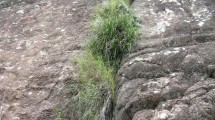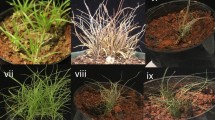Abstract
Desiccation-tolerant plants can be grouped into two categories: the 1) desiccation-tolerant plants whose internal water content rapidly equilibrates to the water potential of the environment and 2) the modified desiccation-tolerant plants that all employ mechanisms to retard and control the rate of water loss. Desiccation tolerance can be achieved by mechanisms that incorporate one of two alternatives, viz. cellular protection or cellular recovery (repair). The majority of plants probably utilize aspects of both. Desiccation-tolerant species, in particular the moss Tortula ruralis, appear to utilize a tolerance strategy that combines a constitutive protection system and a rehydration-inducible recovery mechanism. The rehydration-induced recovery mechanism of Tortula ruralis relies heavily upon a change in gene expression that is mediated by posttranscriptional events rather than the slower reacting transcriptional controls. Findings indicate that it takes a certain amount of prior water loss to fully activate the protein-based portion of the recovery mechanisms upon rehydration. Utilizing cDNAs representing individual hydrins (proteins whose synthesis is hydration specific) and rehydrins (proteins whose synthesis is rehydration specific), it was determined that if drying rates were slow rehydrin transcripts selectively accumulate in the dried gametophytes. Studies revealed that this storage involves the formation of mRNPs (messenger ribonucleoprotein particles). The identity and possible functions of the rehydrins of Tortula ruralis are also under investigation, in particular Tr155, a small rehydrin (24kD) appears to be involved in antioxidant production during rehydration.
Similar content being viewed by others
References
Aalen R.B., Opsahl-Ferstad H.G., Linnestad C., Olsen O.A. 1994. Transcripts encoding an oleosin and a dormancy-related protein are present in both the aleurone layer and in the embryo of developing barley (Hordeum vulgare) Plant J 5: 385–396.
Alpert P. 1987. Morphological control of water relations in an assemblage of mosses. Abstracts of the XIV International Botanical Congress, p 378. Botanical Museum, Berlin-Dahlem, Germany.
Bartels D.R., Nelson D. 1994. Approaches to improve stress tolerance using molecular genetics, Plant Cell Environ 17:659–667.
Bartels D.R., Alexander K., Schneider R., Elster R., Velasco J., Alamillo G., Bianchi G., Nelson D., Salamini F. 1993. Desiccation-related gene products analyzed in a resurrection plant and in barley embryos. In: Plant responses to cellular dehydration during environmental stress, ed. by T.J. Close and E. A. Bray eds.), Current Topics in Plant Physiology: Am. Soc. Plant Physiol. Publ., Rockville, Maryland. 10:119–127.
Bewley J.D. 1972. The conservation of polyribosomes in the moss Tortula ruralis during total desiccation. J Expt Bot 23:692–698.
Bewley J.D. 1973. Desiccation and protein synthesis in the moss Tortula ruralis. Can J Bot 51:203–206.
Bewley J.D. 1979. Physiological aspects of desiccationtolerance, Annu Rev Plant Physiol 30:195–238.
Bewley J.D., Reynolds T.L., Oliver M.J. 1993. Evolving Strategies in the adaptation to desiccation. In: Plant responses to cellular dehydration during environmental stress, ed. by T.J. Close and E. A. Bray eds.), Current Topics in Plant Physiology: Am. Soc. Plant Physiol. Publ., Rockville, Maryland. 10:193–201.
Bewley J.D., Halmer P., Krochko J.E., Winner W.E. 1978. Metabolism of a drought-tolerant and a drought-sensitive moss: respiration, ATP synthesis and carbohydrate status. In: Dry biological systems, ed. by J.H. Crowe and J.S. Clegg, Academic Press, Publ., New York: 185–203.
Bewley J.D., Krochko J.E. 1982. Desiccationtolerance. In: Encyclopedia of Plant Physiology, ed. by O.L. Lange, P.S. Nobel, C.B. Osmond, and H. Ziegler, Vol 12B, Physiological Ecology II, Springer-Verlag, Publ., Berlin: 12B:325–378.
Bewley J.D., Oliver M.J. 1992. Desiccation-tolerance in vegetative plant tissues and seeds: Protein synthesis in relation to desiccation and a potential role for protection and repair mechanisms. In: Water and life: A comparative analysis of water relationships at the organismic, cellular and molecular levels, ed. by C.B. Osmond and G. Somero, Springer-Verlag, Publ., Berlin: 141–160.
Burke M.J. 1986. The glassy state and survival of anhydrous biological systems. pp358–363 In: Membranes, metabolism and dry organisms, ed. by A.C. Leopold, Cornell Univ Press, Publ., Ithaca, NY.: 358–363.
Close T.J., Fenton R.D., Yang A., Asghar R., DeMason D.A., Crone D.E., Meyer N.C., Moonan F. 1993. Dehydrin: The protein pp104–118 In: Plant responses to cellular dehydration during environmental stress, ed. by T.J. Close and E. A. Bray eds.), Current Topics in Plant Physiology: Am. Soc. Plant Physiol. Publ., Rockville, Maryland. 10:104–118.
Crowe J.H., Hoekstra F.A., Crowe L.M. 1992. Anhydrobiosis. Annu Rev Physiol 54:579–599.
Dhindsa R., Bewley J.D. 1977. Water stress and protein synthesis: V. Protein synthesis, protein stability and membrane permeability in a drought-sensitive and drought-tolerant moss. Plant Physiol. 59:295–300.
Dure L III. 1993. A repeating 11-mer amino acid motif and plant desiccation, Plant J 3:363–369.
Gaff D.F. 1989. Responses of desiccation-tolerant “resurrection” plants to water stress. In: Structural and functional responses to environmental stresses. ed. by K.H. Krebb, H. Richter, T.M. Hinkley eds. SPB Academic Publ. The Hague: 255–268.
Goldmark P.J., Curry J., Morris C.F., Walker-Simmons M.K. 1992. Cloning and expression of an embryo-specific mRNA up-regulated in hydrated dormant seeds. Plant Mol Biol 19:433–441.
Henckel R.A., Statrova N.A., Shaposnikova S.V. 1977. Protein synthesis in poikiloxerophyte and wheat embryos during the initial period of swelling, Sov Plant Physiol 14:754–762.
Leopold A.C., Bruni F., Williams R.J. 1992. Water in dry organisms. In: Water and life. Comparative analysis of water relationships at the organismic, cellular and molecular levels, ed. by G.N. Somero, C.B. Osmond, and C.L. Bolis, Springer-Verlag, Publ., Berlin: 161–169.
Oliver M.J. 1983. The role of desiccation in the control of transcription and translation in the moss Tortula ruralis. PhD Thesis, Univ. of Calgary. Calgary, Canada.
Oliver M.J. 1991. Influence of protoplasmic water loss on the control of protein synthesis in the desiccationtolerant moss Tortula ruralis: Ramifications for a repair-based mechanism of desiccation-tolerance, Plant Physiol 97:1501–1511.
Oliver M.J. 1996. Desiccation-tolerance in vegetative plant cells, Physiol Plant 97:779–787.
Oliver M.J., Bewley J.D. 1984a. Desiccation and ultrastructure in bryophytes, Adv Bryol 2:91–131.
Oliver M.J., Bewley J.D. 1984b. Plant desiccation and protein synthesis: IV. RNA synthesis, stability, and recruitment of RNA into protein synthesis upon rehydration of the desiccation-tolerant moss Tortula ruralis. Plant Physiol 74:21–25.
Oliver M.J., Bewley J.D. 1984c. Plant desiccation and protein synthesis: VI. Changes in protein synthesis elicited by desiccation of the moss Tortula ruralis are effected at the translational level. Plant Physiol. 74:923–927.
Oliver M.J., Bewley J.D. 1997. Desiccation-tolerance of plant tissues: a mechanistic overview. Hort Rev 18:171–213.
Platt K.A., Oliver M.J., Thomson W.W. 1994. Membranes and organelles of dehydrated Selaginella and Tortula retain their normal configuration and structural integrity: freeze fracture evidence. Protoplasma 178:57–65.
Schonbeck M.W., Bewley J.D. 1981a. Responses of the moss Tortula ruralis to desiccation treatments. I. Effects of minimum water content and rates of dehydration and rehydration. Can J Bot 59:2698–2706.
Schonbeck M.W., Bewley J.D. 1981b. Responses of the moss Tortula ruralis to desiccation treatments. II. Variations in desiccation tolerance. Can J Bot 59:2707–2712.
Scott H.B. II., Oliver M.J. 1994. Accumulation and polysomal recruitment of transcripts in response to desiccation and rehydration of the moss Tortula ruralis. J. Expt Bot 45:577–583.
Siebert G., Loris J., Zollner B., Frenzel B., Zahn RK. 1976. The conservation of poly (A) containing RNA during the dormant state of the moss Polytrichum commune. Nucl Acid Res 3:1997–2003.
Smirnoff N. 1992. The carbohydrates of bryophytes in relation to desiccation-tolerance. J Bryol 17:185–191.
Strauss G., Hauser H. 1986. Stabilization of small unilamellar phospholipid vesicles by sucrose during freezing and dehydration. p. 318–326. In: Membranes, metabolism and dry organisms, ed. by A.C. Leopold. Cornell Univ. Press, Publ., Ithaca, NY: 318–326.
Werner O., Espin R.M.R., Bopp M., Atzorn R. 1991. Abscisic-acid-induced drought tolerance in Funaria hygrometrica Hedw. Planta 186:99–103.
Willis A.J. 1964. Investigations on the physiological ecology of Tortula ruraliformis. Trans Brit Bryol Soc 4:668–683.
Author information
Authors and Affiliations
Corresponding author
Rights and permissions
About this article
Cite this article
Oliver, M.J., Wood, A.J. & O’Mahony, P. How some plants recover from vegetative desiccation: A repair based strategy. Acta Physiol Plant 19, 419–425 (1997). https://doi.org/10.1007/s11738-997-0038-1
Issue Date:
DOI: https://doi.org/10.1007/s11738-997-0038-1




